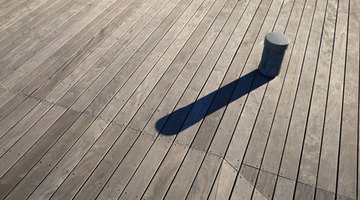Homemade Wood Waterproofing
Waterproofing is an important step in improving the longevity of your outdoor decks, fences or other wooden constructions. It is also useful for preserving smaller objects, such as shelves, furniture, decorative wooden wall hangings and decorative wooden bowls or vases.

Waterproofing not only protects the wood from weather and moisture, but can add color and gloss to your project.
Polyester Resin Method
-
Mix one part polyester resin with four parts acetone in a 1- or 5-gallon bucket. The result should be thicker than water, but thinner than corn syrup.
-
Add the catalyst. The bottle of catalyst will recommend an amount to use for a resin solution. Use that amount for your resin and acetone solution.
-
Mix the polyester resin waterproofing in small batches. The acetone will evaporate quickly, causing the resin to harden in just 20 to 30 minutes.
-
Apply the mixture to the wooden surface with a paintbrush or paint roller. Several coats are recommended. Allow each coat to dry before adding the next coat.
-
Allow the waterproofing to kick, or harden. There are two types of polyester resin. Waxed polyester resin kicks easily, but will require sanding. Unwaxed polyester resin does not require sanding, but will require additional measures to promote kicking. One method of kicking unwaxed polyester resin is to cover the painted surface with a layer of cellophane. Allow the waterproofing to dry, then remove the cellophane.
Linseed Oil Method
-
Mix one part boiled linseed oil with two parts mineral spirits in a 1- or 5-gallon bucket.
-
Stir the mixture thoroughly with a paint stirrer.
-
Apply the mixture to the wooden surface with a paintbrush or paint roller. Several coats may be needed. Allow each coat to dry before applying the next coat.
Tung Oil Method
-
Purchase pure tung oil, rather than tung oil finish. Pure tung oil is made from the nuts of the tung tree, while tung oil finish is a generic term that contractors use for many types of oil finishes.
-
Apply the pure tung oil to the wooden surface with a paintbrush.
-
Allow the pure tung oil to dry for at least seven hours.
-
Sand the dried surface with sandpaper or a power sander. If you use a power sander, be careful not to sand too deeply, or you will damage your wood and remove the benefits of the pure tung oil you just applied.
-
Repeat steps 2 through 4 for each coat of pure tung oil you apply.
Tip
Test your chosen sealant on a portion of wood that is not visible. There may be a change in the color of your wood. If you are unhappy with the results of your test location, try a different sealant. Paint rollers work well for large areas, while paintbrushes are better for small areas or hard to reach locations. To test the effectiveness of your waterproofing, pour a small amount of water on the waterproofed surface. If it beads, without color change, the waterproofing is effective. It it does not bead, or there is a change in color beneath the water, you need to add additional coats of waterproofing.
Warning
Because pure tung oil is made from nuts, it may cause allergic reactions. Do not waterproof objects or utensils that come in contact with food or drinking water. Always mix and apply wood sealant in a well ventilated area.
References
Tips
- Test your chosen sealant on a portion of wood that is not visible. There may be a change in the color of your wood. If you are unhappy with the results of your test location, try a different sealant.
- Paint rollers work well for large areas, while paintbrushes are better for small areas or hard to reach locations.
- To test the effectiveness of your waterproofing, pour a small amount of water on the waterproofed surface. If it beads, without color change, the waterproofing is effective. It it does not bead, or there is a change in color beneath the water, you need to add additional coats of waterproofing.
Warnings
- Because pure tung oil is made from nuts, it may cause allergic reactions.
- Do not waterproof objects or utensils that come in contact with food or drinking water.
- Always mix and apply wood sealant in a well ventilated area.
Writer Bio
Cristel Wood is a writer specializing in food, photography, gardening and video games. She holds an Associate of Arts from South Puget Sound Community College and has worked for her local Parks & Recreation department, Mt. Baker ski area, Vista Village Retirement Community and has taught ESL in Peru.
Photo Credits
- wooden deck background image by d_j_ang0 from Fotolia.com
- wooden deck background image by d_j_ang0 from Fotolia.com
More Articles



